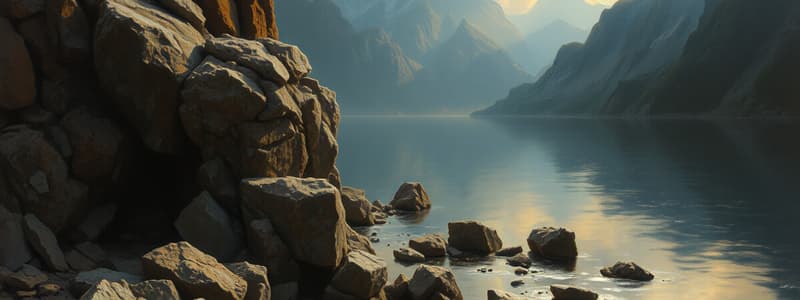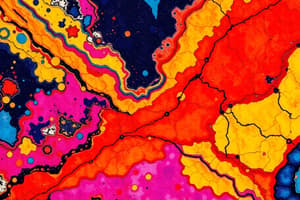Podcast
Questions and Answers
What type of mineral is obsidian classified as?
What type of mineral is obsidian classified as?
- Volcanic glass (correct)
- Amorphous graphite
- Lignite
- Crystalline silica
Which of the following is considered a primary mineral?
Which of the following is considered a primary mineral?
- Apatite (correct)
- Calcite
- Galena
- Clay minerals
Which mineral is known for its use in electric cables?
Which mineral is known for its use in electric cables?
- Halite
- Feldspar
- Copper (correct)
- Iron
What characterizes secondary minerals?
What characterizes secondary minerals?
Which of the following is a copper ore mineral?
Which of the following is a copper ore mineral?
What determines a mineral's suitability as an ore mineral?
What determines a mineral's suitability as an ore mineral?
What is the primary use of feldspar?
What is the primary use of feldspar?
Which mineral requires the least energy to smelt?
Which mineral requires the least energy to smelt?
What are the two main groups of minerals based on color and composition?
What are the two main groups of minerals based on color and composition?
What term refers to the worthless minerals associated with ore minerals?
What term refers to the worthless minerals associated with ore minerals?
Which of the following is a property used to identify minerals?
Which of the following is a property used to identify minerals?
Which mineral is known for its single, perfect cleavage?
Which mineral is known for its single, perfect cleavage?
What characteristic shape is described by the term 'Euhedral'?
What characteristic shape is described by the term 'Euhedral'?
Which of the following minerals is a source of aluminum?
Which of the following minerals is a source of aluminum?
What term is used for a mineral habit composed of slender, needle-like crystals?
What term is used for a mineral habit composed of slender, needle-like crystals?
Which of the following minerals is commonly used in cosmetics?
Which of the following minerals is commonly used in cosmetics?
What is the primary purpose of conducting a flame test?
What is the primary purpose of conducting a flame test?
Which acid can be used to clean the wire loop before a flame test?
Which acid can be used to clean the wire loop before a flame test?
Which of the following tests is NOT used to discriminate between calcite and dolomite?
Which of the following tests is NOT used to discriminate between calcite and dolomite?
How is aragonite identified during the Meigen test?
How is aragonite identified during the Meigen test?
What is indicated by the presence of carbonate minerals in rocks?
What is indicated by the presence of carbonate minerals in rocks?
Which test can differentiate between Magnesite and Smithsonite?
Which test can differentiate between Magnesite and Smithsonite?
What happens to the wire loop before each flame test?
What happens to the wire loop before each flame test?
Which test is associated specifically with the discrimination of aragonite?
Which test is associated specifically with the discrimination of aragonite?
What is the chemical formula for cyclosilicates like Tourmaline?
What is the chemical formula for cyclosilicates like Tourmaline?
Which type of silicate structure is associated with Pyroxene?
Which type of silicate structure is associated with Pyroxene?
Which of the following minerals has a sheet structure?
Which of the following minerals has a sheet structure?
What primarily determines the hardness of a mineral?
What primarily determines the hardness of a mineral?
Which property can help distinguish between calcite and quartz?
Which property can help distinguish between calcite and quartz?
Which statement is NOT true about minerals?
Which statement is NOT true about minerals?
The chemical formula for olivine indicates that ______.
The chemical formula for olivine indicates that ______.
What type of mineral shows variable color?
What type of mineral shows variable color?
Which of the following is not an essential condition for hydrothermal deposits?
Which of the following is not an essential condition for hydrothermal deposits?
What is the most common metamorphic mineral mentioned?
What is the most common metamorphic mineral mentioned?
In which tectonic setting does regional metamorphism occur?
In which tectonic setting does regional metamorphism occur?
What shape does the silicate tetrahedron (SiO4)4- resemble?
What shape does the silicate tetrahedron (SiO4)4- resemble?
Which group of silicate minerals is characterized by independent tetrahedral structures?
Which group of silicate minerals is characterized by independent tetrahedral structures?
Graphite converts to diamond under what conditions?
Graphite converts to diamond under what conditions?
What type of metamorphism is primarily caused by contact with magma?
What type of metamorphism is primarily caused by contact with magma?
What is the base unit of silicate minerals?
What is the base unit of silicate minerals?
Flashcards are hidden until you start studying
Study Notes
Mineral Classification and Properties
- Obsidian: Volcanic glass, non-crystalline (amorphous).
- Jet: Organic lignite, a precursor to coal, non-crystalline.
- Opal: Amorphous silica with chemical composition SiO2·nH2O.
Economic Importance of Minerals
- Copper: Used for electric cables, wires, and switches.
- Feldspar: Utilized in glass, ceramics, and sanitary ware.
- Calcite: Found in toothpaste, construction, and antacid tablets.
- Iron: Major component in buildings, magnets, and cars.
- Halite: Commonly known as table salt, used in food preservation.
- Graphite: Employed in electrical applications, pencils, and lubricants.
Mineral Groups
-
Rock-forming Minerals: Abundant minerals in various rocks, divided into:
- Primary Minerals: Crystallized directly from magma or lava, including essential (define rock) and accessory (do not define rock) minerals.
- Essential examples: Feldspar, quartz, biotite.
- Accessory examples: Zircon, sphene, apatite (major source of phosphorus).
- Secondary Minerals: Formed by the alteration of primary minerals through weathering/hydrothermal processes (e.g., clay minerals).
- Primary Minerals: Crystallized directly from magma or lava, including essential (define rock) and accessory (do not define rock) minerals.
-
Ore-forming Minerals: Minerals suitable for metal extraction.
- Examples: Hematite (Fe2O3 - iron), galena (PbS - lead), malachite (Cu2(CO3)(OH)2 - copper), native gold (Au).
Factors Affecting Ore Minerals
- Suitability determined by:
- Ease of separation from gangue and concentration for smelting.
- Energy required to release metals from mineral bonds; sulfide, oxide, or hydroxide minerals require less energy to smelt than silicate minerals.
Mafic and Felsic Minerals
- Mafic Minerals: Rich in iron and magnesium, generally dark-colored (e.g., olivine, pyroxene).
- Felsic Minerals: Light-colored (e.g., quartz, feldspar).
Gangue and Metallic Minerals
- Gangue Minerals: Non-valuable minerals associated with ore minerals.
- Metallic Minerals: Sources of metals such as iron, aluminum, copper, and more.
Industrial Minerals
- Mined for physical properties such as hardness, color, and luster.
- Applications include abrasives (garnet), cosmetics (calcite, talc), and agricultural uses (phosphates).
Mineral Nomenclature
- Mineral names based on physical properties, chemical composition, locality, or mineralogist.
- Examples include:
- Albite: Named for its white color (Latin: albus).
- Chromite: Contains chromium.
Mineral Identification Techniques
- Identified by physical properties (color, luster, hardness) or advanced methods (XRD, chemical analysis).
- Test methods include flame tests, where a clean wire loop is dipped into a sample to observe emission colors.
Carbonate Minerals
- Key constituents of sedimentary rocks, also found in igneous and metamorphic rocks.
- Identification assists via chemical staining and various discrimination tests (e.g., between calcite and dolomite).
Silicate Minerals Classification
Silicate minerals are the most common on Earth; classified into 7 sub-groups based on their silicate anion structure:
- Nesosilicates: Independent tetrahedra (e.g., Olivine).
- Sorosilicates: Double tetrahedra (e.g., Epidote).
- Inosilicates: Single-chain (e.g., Pyroxene) and double-chain (e.g., Amphibole).
- Phyllosilicates: Sheet structure (e.g., Mica).
- Tectosilicates: 3D frameworks (e.g., Feldspar, Quartz).
Metamorphism and Its Types
- Metamorphism occurs under high temperature and pressure, transforming existing rocks.
- Common metamorphic minerals: garnet and serpentine.
- Types of metamorphism:
- Contact Metamorphism: High temperature, low pressure, driven by nearby magma.
- Regional Metamorphism: High temperature and pressure over large areas, usually at convergent plate boundaries.
Important Mineral Tests
- Tests for differentiating minerals include specific reactions with chemical solutions (e.g., Lemberg test for calcite and dolomite) and response to thermal tests for emissions in flame.
Studying That Suits You
Use AI to generate personalized quizzes and flashcards to suit your learning preferences.




